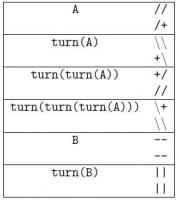QUILT - Little Quilt
Little Quilt is a small language introduced by Ravi Sethi in his book ‘Programming Languages’.
Here, a restricted version of Little Quilt is presented. The language is defined by the following BNF grammar:
< QUILT > ::= A | B | turn(< QUILT >) | sew(< QUILT >,< QUILT >)
A and B represent the two primitive quilts. Each primitive quilt corresponds to a matricial arrangement of 2 × 2 characters. turn() and sew() are operations over quilts.
The instruction turn(x) turns the quilt x 90 degrees clockwise. The following table illustrates the primitive quilts as well as examples of the effect of the turn() operation:

Accordingly, the instruction sew(x,y) sews quilt x to the left of quilt y. Both x and y must have the same height, otherwise an error will be generated. The following figure represents the result of sew(A,turn(B)):

while the sew(turn(sew(B,turn(B))),A) generates an error message.
Your job is to build an interpreter of the Little Quilt language.
Input
The input file will be a text file containing different Little Quilt expressions, each one ended by a semicolon character (;). Space and new line characters must be ignored; this means that an expression may span several lines.
Output
The output file contains the quilts produced as a result of interpreting the input expressions.
Each quilt must be preceded by a line, left aligned, with the format
Quilt i:
where i is the quilt number, starting at 1. If the expression interpretation generates and error, the word error must be printed.
Example
Input: sew(turn(sew(B,turn(B))), turn(sew(turn(B),B))) ;
sew(turn(sew(B,turn(B))),A); sew(turn(sew(A,turn(A))), turn(turn(
turn(sew(A,turn(A)))))) ; Output: Quilt 1: ||-- ||-- --|| --|| Quilt 2: error Quilt 3: \\// +\/+ +/\+ //\\
hide comments
|
|
nadstratosfer:
2020-01-03 00:46:15
Fun little problem. My 4-function solution with header, comments and safe IO handling is 69 lines in Python and was anything but tedious to write. But yeah, if you choose C to solve stuff like this you might as well type with hammers.
|
|
|
Erick Wong:
2019-12-31 03:17:35
Can be done in < 100 lines of code if you structure it well. This is one of the few contest problems where I found it beneficial to use pointers and a custom object. One of my personal faves. |
|
|
niabbf:
2016-11-05 02:38:28
What is the data's range? What size will the final graph be ? |
|
|
Benito:
2013-12-03 04:27:24
Hi I need the solve of this problem :( I dont have time for solve, its for school, please send me the code in Java, send me to produccionesbenito@hotmail.com |
|
|
Santiago Palacio:
2011-06-27 03:55:38
Can we assume the input is valid? i mean, there will be no expressions like sew(a); ? |
|
|
abhijith reddy d:
2009-10-10 02:43:19
A Tedious one !! |
| Added by: | Camilo Andrés Varela León |
| Date: | 2006-10-25 |
| Time limit: | 0.200s-0.400s |
| Source limit: | 50000B |
| Memory limit: | 1536MB |
| Cluster: | Cube (Intel G860) |
| Languages: | All except: ERL JS-RHINO NODEJS PERL6 VB.NET |
| Resource: | XX Colombian National Programming ACM 2006 |

 RSS
RSS